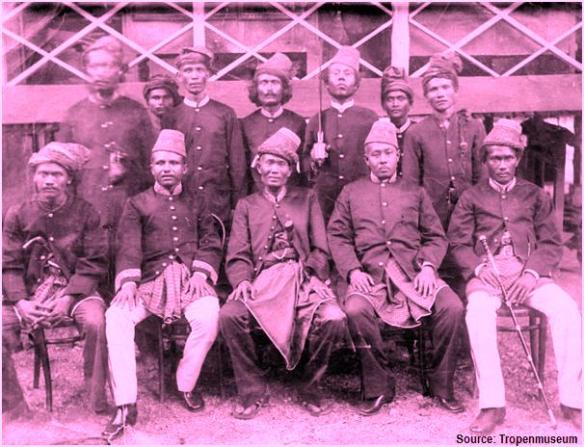London anno 1824, Netherlands, and Great Britain decided to ascertain their colonial dominions in Southeast Asia, drawing a boundary line dividing Malacca Strait from north to south in two territories. The western region included Sumatera island, excepted Aceh, would be ruled by Dutch East Indies while the eastern part which covered the whole Malay peninsula and Singapore Island by the United Kingdom. Both countries had to recognize the sovereignty of Aceh. The demarcation of those two territories was known as London Agreement 1824.
After a brief military intervention in 1834 and Indragiri in 1838, Jambi recognized Dutch sovereignty. However, Britain objected to the Dutch to carry out an expansion north of the Equator as, under the London treaty, the Dutch didn’t have a right to do so. In 1850, having experienced internal political struggles, the Siak Sultan appealed for Dutch protection costing the sultanate to hand over Deli, Langkat, Asahan, and Serdang territories to the Dutch. However, since Sultan Iskandar Muda, those areas were under the control of Aceh, and Aceh people considered that Siak Treaty was contrary to the London Agreement. Since then, being supported by Britain, they drowned Dutch ships passing through the Aceh sea waters.
Post of the opening of the Suez Canal, Britain and the Netherland again signed the London Treaty in 1871 to secure Aceh waters that became a vital sea-lane trading. Under the new treaty, Britain gave Dutch freedom to take action in Aceh to maintain the security of maritime traffic in the area.
On March 26, 1873, Dutch colonials declared war on Aceh, and 3,198 Dutch troops in which 168 were officers under the command of General Rudolf Köhler landed and immediately occupied the Great Mosque of Baiturrahman. Panglima Polim and Sultan Mahmud led Acehnese guerillas. Only two weeks after the war began, it was taken over by Acehnese. At the surprise of colonial troops, their high commander General Kohler was shot dead by an Acehnese sniper.
In 1874 General Jan van Swieten led the Dutch troops to occupy the Sultan’s palace, which they converted into their defending center. Sultan died in the same year, and Tuanku Muhammad Dawood replaced him taking the role to lead the war in cooperation with Teuku Umar and Panglima Polim. The capital of Aceh Sultanate was removed to Indrapuri and successively to other places in the hinterland.
In 1890, the Dutch East Indies government established marechaussee corps (local people spelled it as ‘marsose’), elite troops dedicated to counter-guerrilla operations against the Acehnese warriors. In the eyes of the Aceh warriors, this marsose was very hated, but also appreciated for their courage.
In 1893, Teuku Umar pretended to surrender to Deykerhooff, Dutch Governor in Kutaraja, and became Dutch military. He pretended to attack many Acehnese guerilla posts to convince the Dutch of his loyalty. Because of his outstanding achievements, the governor awarded Umar the title of Teuku Johan Pahlawan, which was a trick to draw Aceh people’s sympathy.
Three years later, Umar deserted from Dutch military carrying with him 800 rifles complete with bullets and ammunition and pretty amount of money. The Dutch Government immediately fired Deykerhooff and replaced him with General Vetter, who gave Umar a futile ultimatum to bring back all rifles and ammunition.
In 1899, Umar and his troops arrived at the peripheral area of Meulaboh, where he was suddenly surrounded and attacked by Van Heutsz and shot dead. The war went on, and his wife Cut Nyak Dien took over the leader of guerillas. Her health condition, however, was worsened and eventually arrested by the Dutch, and she died in exile in 1908 in Sumedang.
After the death of Umar, the guerrilla war had no strong field commander with a directive strategy. The war practically ended in 1904, during which time the surrendered Aceh leaders had to sign the Short Tractate, where they had to recognize the Dutch Indies sovereignty upon their regions.
Lasting from 1873 to 1904, the cost that Dutch had to spend during the war was immense. Aceh war was fierce for Dutch colonials. The Acehnese fighters were courageous and unafraid to face any attack. They were in a deep love of freedom and so passionate about the battlefield.
To counter Acehnese warriors, Dutch military Aceh governor Van Heutz ordered Snouck Hurgronje, an Oriental Culture and Language scholar who spent two years to make an in-depth study about Aceh society during his living in Aceh (1889-1905). He suggested the governor put aside Sultan and his inner circle but continue fighting ulemas without holding a peaceful meeting with Acehnese warriors. To draw Acehnese people’s sympathy, the governor should help commoners constructing mosques, water irrigation for rice-paddy, and improve road conditions.
A retired infantryman Lieutenant Colonel G.B. Hooijer who had served in Aceh, wrote his overview on Aceh war in 1895:
“No Diponegoro or Sentot troops, either Padri’s fanatics or the entourage of Balinese or horsemen of Bone people, as the Acehnese fighters who were brave and fearlessly encountered an attack, who were highly self-confident, so persistently facing their fate, loved freedom, who were so fanatic as if they were born to their nation’s guerrillas. As such, the Dutch war in Aceh will remain to be a source of learning for our troops.
But of all our battle commanders who have fought in every corner of our archipelago, we heard that no tribe was so brave and passionate in warfare except the Acehnese; their women also had the courage and willingness to sacrifice much more than other women.”



